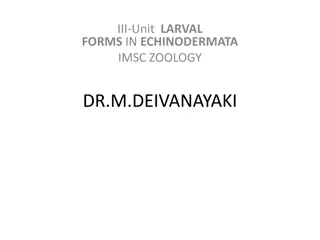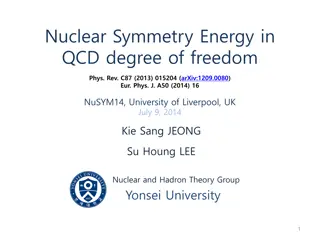Insights into Symmetry and Magnetism in Summer School Curriculum
Delve into the principles and applications of symmetry in magnetism through topics like tensor transformations, Edelstein effect, and breaking inversion symmetry in magnetic materials. Explore the role of crystal structures and interfaces in breaking symmetry, especially in antiferromagnets, providi
2 views • 39 slides
Principles and Applications of Symmetry in Magnetism Summer School Lecture
This lecture delves into the principles and applications of symmetry in magnetism, covering topics such as the symmetry of response tensors, transformations of tensors, time-reversal symmetry, and beyond point groups. It explores the symmetry of local effects, equivalent magnetic configurations, exp
2 views • 14 slides
Understanding Cleavage in Zygote: Patterns, Types, and Laws
Cleavage is the division process in a zygote that lays the foundation for cellular differentiation. It involves specific patterns like radial, bilateral, and spiral cleavage, with determinate or indeterminate fate of blastomeres. Various laws govern cleavage, including Sach's, Hertwig's, and Balfour
9 views • 24 slides
Urban Planning and Road Design Guidelines
Explore various road patterns like rectangular, radial, and hexagonal, along with classifications from arterial to local streets. Understand design considerations such as speed limits, access, and spacing for different road types. Learn about factors influencing road alignment and requirements for h
0 views • 21 slides
Larval Forms in Echinoderms: Development and Diversity
Echinoderms exhibit various larval forms as part of their life cycle, with different classes showcasing distinct types of larvae. These larvae undergo metamorphosis to transition into the characteristic radial symmetrical adults. The bipinnaria, brachiolaria, auricularia, and ophiopluteus larvae are
1 views • 8 slides
Larval Forms in Echinodermata: A Study of Development Stages
Echinoderms, as deuterostomes, exhibit radial and indeterminate cleavage. Their larvae undergo metamorphosis to become adults through various stages. Different classes of echinoderms have distinct larval forms, such as Bipinnaria, Brachiolaria, Auricularia, and more. These larvae display bilateral s
0 views • 8 slides
Best Practices for Transradial Angiography & Intervention Update
Expert consensus statements provide guidance on utilizing ultrasound guidance for arterial access, preferring radial over ulnar artery access, and the utility of non-invasive collateral flow assessment. Recommendations include administering heparin post-sheath placement and using low-profile sheaths
0 views • 7 slides
Understanding Symmetry and Group Theory in Chemistry
Exploring the world of symmetry elements in molecules, encompassing identity, proper axis of symmetry, centre of symmetry, and plane of symmetry. Learn how these elements help in identifying the symmetry of molecules quantitatively, with examples like N2F2, H2O, C2H4, NH3, and Dichlorobenzene.
1 views • 12 slides
Fun Symmetrical Figures Activities for Learning and Creativity
Engage in a series of interactive activities involving color, symmetry, and reflection with symmetrical figures. From coloring squares to completing shapes along the line of symmetry, explore the properties of shapes while enhancing creativity and problem-solving skills.
0 views • 18 slides
Understanding Symmetry in Shapes: A Visual Exploration
Delve into the world of symmetry with explanations and visual examples of line symmetry in shapes like squares, kites, and parallelograms. Explore the concept of rotational symmetry and try your hand at completing shapes based on given lines of symmetry. Discover the special properties of the letter
1 views • 23 slides
Understanding Relations and Functions in Mathematics
This chapter explores various types of relations and functions, including empty and universal relations, equivalence relations, and common errors in understanding symmetry. It also delves into the concept of reflexivity, symmetry, and transitivity in relations, with practical examples provided for b
1 views • 16 slides
Geometry Learning - Lines of Symmetry Activities
Explore various activities focused on lines of symmetry in shapes. Engage in identifying symmetrical shapes, finding lines of symmetry through folding, sorting shapes based on symmetrical properties, drawing lines of symmetry, and reasoning about symmetrical shapes. Enhance your understanding of sym
0 views • 16 slides
Understanding Symmetry in Structures and Aesthetics
Exploring the concept of symmetry and its impact on form, function, and aesthetics in structures. Symmetry plays a crucial role in identifying and appreciating the beauty of objects, with examples ranging from nature to architectural marvels like the Taj Mahal and Hundertwasser's unconventional desi
0 views • 15 slides
Understanding Curl-Free and Div-Free Radial Basis Functions in Physical Situations
This content explores the applications of Curl-Free and Div-Free Radial Basis Functions in solving partial differential equations for fields, the theoretical soundness of using RBFs, and examples illustrating divergence-free interpolation. It also delves into matrix-valued RBF formulations, converge
3 views • 13 slides
Understanding the C2h Point Group: Character Table, Characteristics, and Subgroups
Characteristics of the C2h point group, including its order and irreducible representations, as well as details on its symmetry elements and subgroups. Examples of molecules with C2h symmetry are provided. Explore the construction and properties of the C2h point group in crystallography.
0 views • 10 slides
General Characters and Classification of Echinodermata in Zoology: B.Sc. 2nd Sem
Echinoderms, marine animals with radial symmetry, feature a unique water vascular system. This content covers their general characteristics, five classes, and a classification table. Dr. Merina Narah from Silapathar College, Assam, presents valuable insights into the fascinating world of Echinoderma
0 views • 5 slides
Hyper-Spherical Harmonics and Multi-Particle Quantum Systems
Explore the application of hyper-spherical harmonics in solving multi-particle quantum systems, focusing on permutation symmetry and splitting wave functions into radial and angular components. The approach involves using center-of-mass reference systems, Jacobi coordinates for different masses, and
0 views • 21 slides
Exploring Symmetry in the Alphabet: Rotation and Reflection Symmetries
Discover how rotation and reflection symmetries play a role in the alphabet, with most letters exhibiting some type of symmetry. Explore rotational symmetries both in and perpendicular to the plane, as well as symmetries across horizontal and vertical axes. Learn about the concepts of rotational sym
0 views • 13 slides
Exploring the Fascination with Symmetry in Art and Nature
Delve into the captivating world of symmetry and its appeal to humans. Symmetry, whether reflectional or rotational, resonates with our aesthetic sense by showcasing balance, repetition, and identical patterns. Through images and definitions, uncover the beauty and significance of symmetry in variou
0 views • 27 slides
Exploring Quadrilaterals and Symmetry Concepts
Delve into the world of quadrilaterals by identifying their properties, understanding rotational symmetry, and tackling questions on angles and shapes. Engage in activities to enhance your knowledge and skills in geometry.
0 views • 28 slides
Understanding Electron Paramagnetic Resonance (EPR) and Molecular Symmetry
The discussion covers the relevance and applications of EPR spectroscopy in studying electron behavior, spin-orbit coupling effects, and molecular symmetry. Key concepts include anisotropy, nuclear spin coupling, and deviations in electron g-factors. It delves into how these factors impact the obser
0 views • 11 slides
Understanding Jeans Equations in Stellar Dynamics
The Jeans Equations and Collisionless Boltzmann Equation play a crucial role in describing the distribution of stars in a gravitational potential. By applying assumptions like axial symmetry and spherical symmetry, these equations provide insights into the behavior of large systems of stars. Despite
0 views • 7 slides
Study of Phylum Cnidaria: General Characters and Classification
Phylum Cnidaria comprises aquatic organisms with specialized stinging cells known as cnidoblasts. They exhibit radial symmetry and are triploblastic, with distinct polyp and medusa forms. The phylum includes classes like Hydrozoa, Scyphozoa, and Anthozoa, each displaying unique characteristics and m
0 views • 6 slides
Overview of Phylum Cnidaria: Classification and Characteristics
Phylum Cnidaria consists of around 10,000 species classified into 5 classes: Hydrozoa, Anthozoa, Cubozoa, Scyphozoa, and Staurozoa. Each class has unique characteristics and examples, such as the sea serpents in Hydrozoa and flower animals in Anthozoa. Cnidarians exhibit radial or biradial symmetry,
0 views • 16 slides
Graphing Polar Equations: Examples and Symmetry Tests
Explore examples of graphing polar equations like r = 3, r = 4sin(θ), and more. Learn how to identify and graph such equations, along with tests for symmetry in polar graphs. Understand the relationship between polar axis, lines, and the pole in polar coordinate systems.
0 views • 15 slides
Exploring Nuclear Symmetry Energy with QCD Sum Rule
This study delves into the concept of nuclear symmetry energy through the lens of QCD Sum Rule, discussing its implications in Rare Isotope Accelerator Plan and nucleon-nucleus scattering. Utilizing mean field approximation and Borel transformation, the research aims to understand asymmetric nuclear
0 views • 21 slides
Nuclear Symmetry Energy in QCD Degree of Freedom
Understanding the nuclear symmetry energy in the context of Quantum Chromodynamics (QCD) is essential for nuclear phenomenology. This study explores topics such as QCD sum rules, mean field approximation, and operator product expansion to decipher the energy properties of nuclear systems. The resear
0 views • 15 slides
Crystal Geometry Systems and Symmetry Elements
Crystal geometry involves the study of seven crystal systems defined by three symmetry elements - centre of symmetry, planes of symmetry, and axes of symmetry. These symmetry elements play crucial roles in determining the geometric properties of crystals. The centre of symmetry, plane of symmetry, a
0 views • 12 slides
Influence of Fermionic Exchange Symmetry Beyond Pauli's Exclusion Principle
Christian Schilling from the University of Oxford delves into quantifying the impact of fermionic exchange symmetry, going beyond Pauli's exclusion principle. The study explores generalized Pauli constraints, concrete systems analysis, and the relevance of (quasi) pinning. Collaborating with various
0 views • 27 slides
Deciphering Heavy Atom Coordinates from Difference Patterson Map: An Overview
Understanding how to determine heavy atom coordinates from a difference Patterson map involves recognizing the relationship between Patterson peak coordinates (u,v,w) and space group symmetry operators in crystallography. By solving equations that relate these coordinates, the absolute positions of
0 views • 5 slides
Exploring Rotations and Rotational Symmetry in Geometry
Delve into the concepts of rotations, rotational symmetry, and the Windmill Method in geometry. Learn about different types of rotations, how to rotate points around the origin, practice rotations with given points, and understand rotational symmetry in objects. Discover the principles of rotating o
0 views • 9 slides
Trigonometry Concepts: Graphs, Symmetry, and Laws Explained
Explore trigonometry concepts such as sine, cosine, and tangent graphs, symmetry in trigonometric functions, and laws of trigonometric functions. Understand how to determine values using symmetry and graph analysis. Practice identifying values in the range 0 to 360 for sine, cosine, and tangent func
0 views • 22 slides
Exploring Topological Band Theory and Quantum Phases in Electronic Matter
Delve into the fascinating realm of topological band theory, examining the insulating state, band topology in different dimensions, symmetry-protected topological band insulators, and the interplay between symmetry and topology. Uncover the principles underlying matter symmetry, quantum phases, and
0 views • 29 slides
Impact of Symmetry and Eye Color on Perceived Attractiveness in Female College Students
This research explores the effects of facial symmetry and eye color on perceived attractiveness and mate quality in female college students. The study investigates whether symmetrical faces and certain eye colors enhance attractiveness and mate selection. Factors such as bilateral symmetry, fluctuat
0 views • 13 slides
Sketching Graphs of Functions: Techniques and Examples
The art of sketching graphs of functions involves representing specific shapes and behaviors through labeled diagrams. This lesson highlights key details to keep in mind when sketching functions, such as labeling axes, maximum and minimum values, intercepts, symmetry, and asymptotes. Two examples of
0 views • 16 slides
Percutaneous Repair of Radial Artery Pseudoaneurysm - Case Study
A 61-year-old male with a history of diabetes, hypertension, and coronary artery disease presented with abnormal body movements suggestive of seizures. Following admission and neurology evaluation, a radial artery pseudoaneurysm was incidentally discovered. Percutaneous transluminal angioplasty (PTA
0 views • 5 slides
Bolted Joints with Radial Pretension for Thick-Walled Composite Structures
Explore the advancements in bolted joints with radial pretension for thick-walled composite structures discussed at the ICCS20 conference. Key topics include state-of-the-art techniques, analytical approaches, FE calculations, bearing tests, and overcoming challenges in bolted joint designs. The con
0 views • 27 slides
Best Practices for Transradial Angiography and Intervention
This update highlights best practices for transradial angiography and intervention, including topics such as ultrasound guidance for transradial access, ulnar artery access recommendations, and future study opportunities. The importance of developing proficiency with ultrasound guidance, utilizing r
0 views • 15 slides
Understanding Conservation Laws: Charge Conjugation, Parity Symmetry, and Violation
In this comprehensive guide, we delve into the intricate concepts of charge conjugation symmetry, G-parity, and the conservation and violation of parity symmetry in fundamental physics. Explore how these principles apply to strong, electromagnetic, and weak interactions through detailed explanations
0 views • 14 slides
Structural Parameters and Symmetry Operations of Organic Compounds
This document presents detailed structural parameters of various organic compounds along with their space groups, crystal systems, and symmetry operations including rotary inversion, screw axis, and glide plane. The data includes molecular formulas, molecular weights, unit cell dimensions, and refle
0 views • 7 slides







































